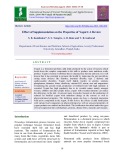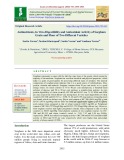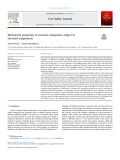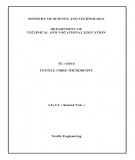
Fibre types and properties
-
In this review, the effects of milk fortification with various food components on physicochemical as well on sensorial properties of yogurt products are studied and described. The fortification described under the types of food components like carbohydrates, proteins, dietary fibres, minerals and vitamins.
 21p
21p  trinhthamhodang11
trinhthamhodang11
 27-04-2021
27-04-2021
 22
22
 2
2
 Download
Download
-
Sorghum commonly is eaten with the hull (the outer layer of the grain), which retains the majority of the nutrients. Sorghum has excellent chemical and physical properties, which make it a grain of good quality for processing different types of products. The nutrient composition of sorghum grain indicates that it is a good source of carbohydrates, fibre, protein, vitamins and minerals. Sorghum contains about 70 per cent starch, so is a good energy source.
 9p
9p  kequaidan4
kequaidan4
 05-05-2020
05-05-2020
 13
13
 2
2
 Download
Download
-
Germination is an effective process to improve sensory properties, nutrients and can decrease the anti-nutrient contents of the seeds. Buckwheat is rich in fibre, phenolic compounds and protein of balanced aminoacid composition. The aim of the present work was to evaluate the suitability of germinated buckwheat milk for development of traditional recipe i.e. payasam. Three types of formulations were prepared with germinated buckwheat milk ranged from 25, 50 and 75%. These products were evaluated for sensory attributes. Payasam prepared with 100% milk was served as control.
 4p
4p  cothumenhmong1
cothumenhmong1
 08-12-2019
08-12-2019
 9
9
 1
1
 Download
Download
-
The paper deals with observing the behaviour of concrete composites with addition of fibres under ambient and elevated temperature with the aim to determine the mechanical properties of materials. The experimental tests were conducted on three selected concrete composites which differ in a type and content of fibrous reinforcement used. The experimental work carried out was divided into several phases. First of all it was necessary to leave the produced specimens aging and drying in order to minimize the risk of unexpected damage caused by concrete spalling during heating.
 11p
11p  christian2605
christian2605
 10-10-2019
10-10-2019
 33
33
 0
0
 Download
Download
-
The high temperatures of fires affect the physical and chemical properties of the concrete and thus influence its mechanical properties. This paper presents the results of an experimental investigation on the compressive strength at high temperatures of high-strength fibre concretes. The influence of the high temperatures on the physical and chemical changes of the concrete was also analysed by Thermo Gravimetric Analysis/Differential Thermal Analysis (TGA/DTA), X-Ray Diffraction (XRD) and Scanning Electron Microscopy with Energy Dispersive Spectrometry (SEM/EDS).
 20p
20p  christian2605
christian2605
 10-10-2019
10-10-2019
 24
24
 2
2
 Download
Download
-
Today, the advancement of technology and the achievement of increasing innovations in the field of building materials have increased high-strength concrete (HSC) production. The use of this material has been increased due to economic and technical reasons in the construction of concrete sections. However, the more compressive strength of the concrete is, the more concrete becomes brittle and its tensile strength does not increase with increasing compressive strength. HSC is also more vulnerable to high temperatures due to its high density and low porosity compared to conventional concrete.
 8p
8p  christian2605
christian2605
 10-10-2019
10-10-2019
 54
54
 0
0
 Download
Download
-
Following the contents part 1, part 2 of the document Textile fibre microscopy presented the contents: Fibre types and properties (Kinds of Fibres, Fibres properties, general classification of textile Fibres), cotton, flax.
 103p
103p  tramnamcodon_07
tramnamcodon_07
 26-04-2016
26-04-2016
 42
42
 7
7
 Download
Download
-
V-Belt and Rope Drives 1. Introduction. 2. Types of V-belts and Pulleys. 3. Standard Pitch Lengths of V-belts. 4. Advantages and Disadvantages of V-belt Drive over Flat Belt Drive. 5. Ratio of Driving Tensions for V-belt. 6. V-flat Drives. 7. Rope Drives. 8. Fibre Ropes. 9. Advantages of Fibre Rope Drives. 10. Sheave for Fibre Ropes. 11. Ratio of Driving Tensions for Fibre Rope. 12. Wire Ropes. 13. Advantages of Wire Ropes. 14. Construction of Wire Ropes. 15. Classification of Wire Ropes. 16. Designation of Wire Ropes. 17. Properties of Wire Ropes. 18.
 32p
32p  tieutaithan
tieutaithan
 15-11-2010
15-11-2010
 96
96
 4
4
 Download
Download
-
CONTENTS CONTENTS V-belt and Rope Drives C H A P T E R n 727 20 V-Belt and Rope Drives 1. Introduction. 2. Types of V-belts and Pulleys. 3. Standard Pitch Lengths of V-belts. 4. Advantages and Disadvantages of V-belt Drive over Flat Belt Drive. 5. Ratio of Driving Tensions for V-belt. 6. V-flat Drives. 7. Rope Drives. 8. Fibre Ropes. 9. Advantages of Fibre Rope Drives. 10. Sheave for Fibre Ropes. 11. Ratio of Driving Tensions for Fibre Rope. 12. Wire Ropes. 13. Advantages of Wire Ropes. 14. Construction of Wire Ropes. 15. Classification of Wire Ropes. 16. Designation of Wire Ropes. 17.
 32p
32p  hadalabo
hadalabo
 29-09-2010
29-09-2010
 92
92
 13
13
 Download
Download
CHỦ ĐỀ BẠN MUỐN TÌM





















